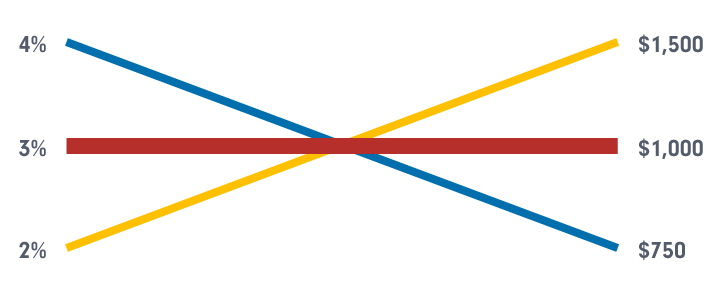Understanding the Relationship between Interest Rates and the US Bond Market
The US bond market is one of the largest and most active bond markets globally, characterized by its immense scale, high liquidity, strong security, market transparency, and significant influence. Within the US bond market, changes in interest rates play a crucial role and have profound effects on bond prices and investment returns.
- Inverse Relationship between Interest Rates and Bond Prices
There exists an inverse relationship between interest rates and bond prices. This is because bond prices are calculated based on the present value of their future cash flows, and changes in interest rates affect this discounting process. When interest rates rise, bond prices tend to fall, and when interest rates decline, bond prices tend to rise.

Bonds are a type of fixed-income security that is issued with a predetermined fixed interest rate, also known as the coupon rate. This means that investors holding bonds will receive interest payments based on the fixed rate during the bond's term. When overall market interest rates rise, newly issued bonds often offer higher rates to attract investors. This leads to relatively lower fixed rates for already issued bonds, making them less competitive compared to newly issued bonds.
The price of a bond is determined by the amount investors are willing to pay for it. When calculating the bond price, investors discount the future cash flows of the bond back to their present value. Discounting is a method used to determine the present value of future cash flows. The interest rate plays a crucial role in the discounting process. Higher rates result in higher discount rates, which decrease the present value of the bond and lower its price. In other words, the present value of the bond's future cash flows is lower at higher discount rates, so investors are willing to pay a lower price for it. Conversely, when rates decrease, bond prices increase. Lower rates lead to lower discount rates, increasing the present value of the bond and raising its price. Investors are willing to pay a higher price to hold bonds at lower rates.
Impact of Rising Interest Rates on US Bonds:
- Decrease in existing bond prices: The inverse relationship in the bond market.
- Investor preference for safe-haven assets: Seeking refuge in safe-haven assets.
When interest rates rise, newly issued bonds typically offer higher rates to attract investors. This may create competitive pressure on existing bond investments, as investors may prefer to purchase new bonds with higher rates rather than continue holding existing low-yield bonds, increasing reinvestment risk for bond investors.
- Increased bond issuance costs: Challenges for c0rporate and government financing.
Rising rates can lead to higher issuance costs for bonds. When issuing new bonds, issuers need to offer higher rates to attract investors. This may increase borrowing costs for corporations and governments, impacting economic activities to some extent.
- Impact of bond duration
Bond duration is an indicator of the sensitivity of bond prices to changes in interest rates. When rates rise, bonds with longer durations experience larger price declines because they are more sensitive to interest rate changes.
Impact of Decreasing Interest Rates on US Bonds:
- Increase in existing bond prices: The positive relationship in the bond market.
- Investor preference for alternative investments with higher returns: Seeking higher returns from alternative investments.
In a low-interest-rate environment, bond returns are relatively lower, so investors may reallocate some funds from bonds to other asset classes such as stocks, real estate, or other high-return assets. This asset allocation adjustment may be driven by the pursuit of higher returns or better risk-adjusted returns.
- Decrease in borrowing costs: Increased activity in the capital market.
Decreasing rates provide opportunities for corporations and governments to obtain financing. Lower rates mean they can borrow funds at lower costs. Companies can utilize this opportunity to expand their businesses, make new investments, or refinance debt, thereby reducing financial costs and improving profitability. This may lead to an increase in the stock market and provide more investment opportunities.
- Increase in inflation expectations
Decreasing rates may lead to increased market expectations of future inflation. A low-interest-rate environment often stimulates consumption and investment demand, which may result in price inflation. If inflation rises and exceeds bond yields, the real interest rate can become negative, reducing the actual return on bonds.
Long-term Considerations and Strategies:
The bond market is generally sensitive to changes in interest rates. Long-term bonds (such as U.S. Treasury bonds) usually have longer maturities, making their price responses to interest rate changes more pronounced. Bonds with longer maturities have higher durations, and the higher the duration, the more sensitive they are to interest rate movements.
Here are some methods to manage risk in a fluctuating interest rate environment:
- Diversify investment portfolios: By diversifying investments across different asset classes, investors can reduce reliance on a single asset. Investors can include cash, bonds, stocks, real estate, and other investment instruments to achieve better risk diversification in different market environments.
- Manage bond duration risk:Duration is an indicator of the sensitivity of bond prices to interest rate changes. Investors can choose bonds with appropriate durations based on interest rate expectations and risk tolerance. Bonds with shorter maturities generally have less impact from interest rate fluctuations, while bonds with longer maturities are more sensitive to interest rate changes.
- Monitor economic and interest rate trends: Keeping a close eye on economic developments and interest rate trends is crucial for investment decisions. Understanding the impact of economic data, monetary policy, and market expectations on interest rates helps investors better predict interest rate movements and manage portfolio risk accordingly.
- Consider a combination of fixed-rate and floating-rate bonds: Investors can combine fixed-rate and floating-rate bonds based on their risk preferences and market expectations. This helps balance the risk between fixed income and interest rate sensitivity in a volatile interest rate environment.




